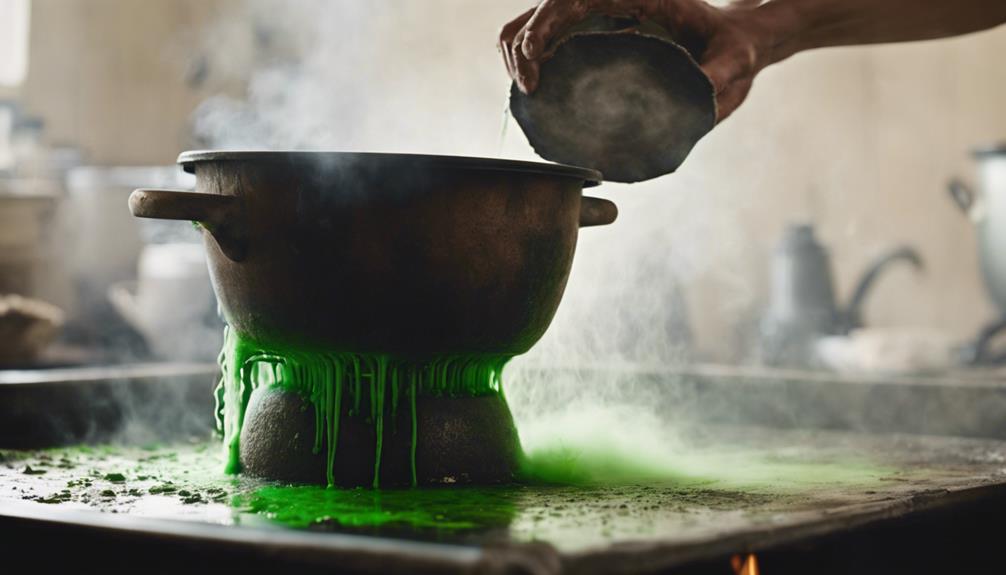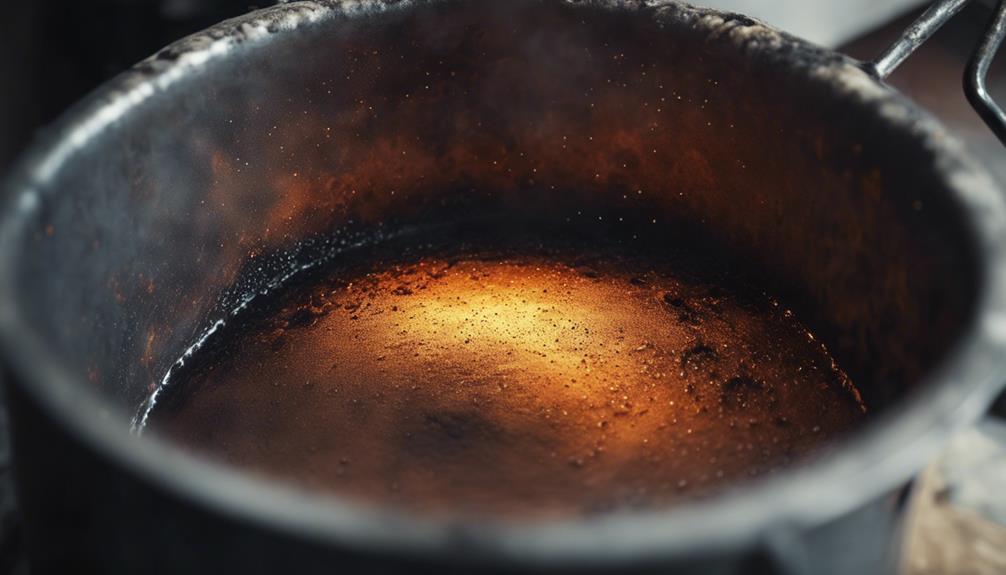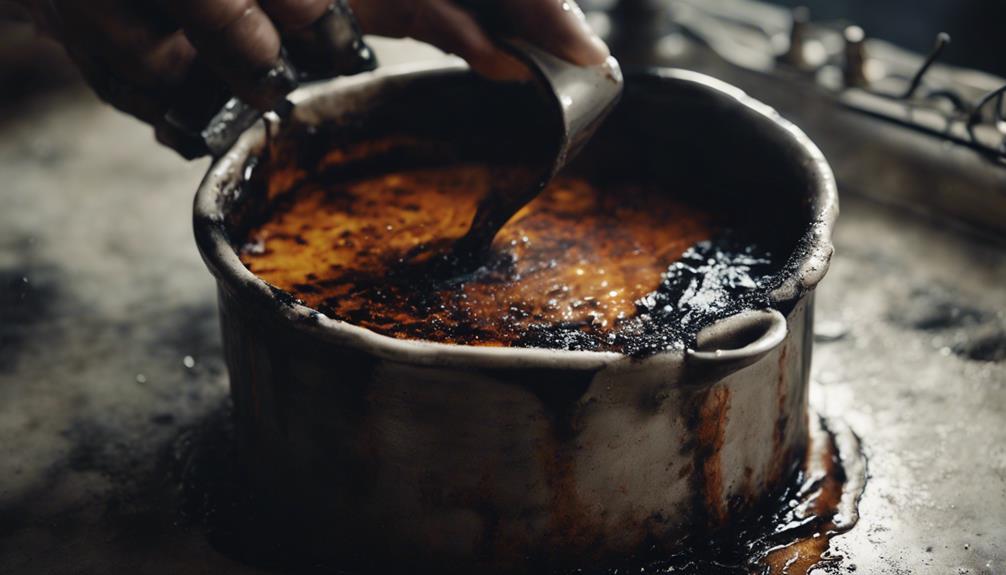To clean a burnt pot, create a mixture of vinegar and water and boil it for 8 minutes. Scrub the pot with a sponge or brillo pad to remove burnt residue. Add dish soap for extra cleaning power. This method is effective, eco-friendly, and budget-friendly. Once the pot is clean, it will look brand new. Remember to maintain your pots regularly to prevent burnt-on food. These steps will help you clean your burnt pot efficiently.
Vinegar and Water Solution
To effectively clean a burnt pot, start by boiling a 50/50 vinegar and water solution. The acidic nature of the vinegar helps break down stubborn burnt-on food, making it easier to scrub away with a sponge or brillo pad.
This cost-effective and environmentally friendly method not only restores your pot but also leaves it looking shiny. Vinegar's acidity plays a key role in this process, as it works to dissolve the tough residues that have stuck to the pot's surface. By using this natural solution, you can avoid harsh chemicals and still achieve a sparkling clean result.
Once you've boiled the vinegar and water mixture in the burnt pot, the next step of scrubbing becomes more manageable. Embracing this simple yet effective cleaning technique won't only save your pot but also help you maintain a chemical-free and eco-conscious approach to household chores.
Boil the Mixture
Boil the mixture of distilled white vinegar and water to effectively loosen burnt-on residue in your pot. The acidic properties of the vinegar help break down tough burnt food particles, making scrubbing easier.
By heating the vinegar and water solution, you allow it to penetrate and dissolve the burnt-on residue more effectively. Boil the mixture for approximately 8 minutes to achieve the best results.
This method isn't only cost-effective but also eco-friendly, providing a simple solution to clean your burnt pot. The combination of vinegar and water creates a powerful solution that can tackle even the most stubborn burnt-on stains.
Embracing this approach saves you time and effort in cleaning, allowing you to restore your pot to its former glory without harsh chemicals. Give this method a try and witness how boiling this mixture can make a significant difference in cleaning your burnt pot.
Scrub With Sponge or Pad

When cleaning a burnt pot, it is important to choose the right tool based on the severity of the burn. For light burns, a sponge can be effective, while a brillo pad may be necessary for more stubborn stains. Apply gentle pressure as you scrub the pot to avoid damaging its surface. Make sure to use hot, soapy water in conjunction with the chosen scrubbing tool for the best results.
Remember to consider the severity of the burn when selecting your cleaning tool and to be gentle yet thorough in your scrubbing to achieve optimal results.
Choose Non-Abrasive Tools
Consider using non-abrasive tools like sponges or pads to gently scrub away burnt residue from your pot's surface. When dealing with burnt-on food, these tools are effective in cleaning stainless steel cookware without causing scratches.
The gentle scrubbing action of a sponge or pad helps lift the burnt residue without damaging the pot's surface. Opting for non-abrasive tools guarantees that your pot remains in good condition even after a thorough cleaning session.
Whether you're working with stainless steel or aluminum pots, sponges or pads are suitable choices for tackling burnt-on messes. By utilizing these tools, you can effectively remove tough burnt spots from your pot without worrying about causing any harm.
Next time you encounter a burnt pot, reach for a non-abrasive sponge or pad to make the cleaning process easier and safer.
Apply Gentle Pressure
To effectively clean a burnt pot, make sure to gently apply pressure while scrubbing with a sponge or pad to remove stubborn burnt residue without causing damage. When dealing with burnt spots, using a brillo pad can provide extra scrubbing power without harming the pot's surface.
The gentle pressure applied during scrubbing helps lift off burnt food particles effectively. Be certain that the sponge or pad is damp to aid in the cleaning process and prevent scratching.
For tougher burnt residue, you can create a baking soda paste by mixing baking soda with a small amount of water to form a thick consistency. Apply this paste to the burnt areas and let it sit for a few minutes before scrubbing with a scrub brush, sponge, or brillo pad.
The combination of gentle pressure and the right cleaning tools will leave your pot looking clean and free of burnt residue. Remember, patience and consistent scrubbing are key to achieving the best results without damaging the pot.
Use Hot Soapy Water
Soak the burnt pot in hot, soapy water to help guarantee the burnt-on residue is loosened before scrubbing with a non-abrasive sponge or pad.
The hot water and soap work together to break down the burnt-on residue, making it easier to clean. Avoid using harsh abrasives that could potentially damage the pot's surface; opt for a gentle scrubbing pad instead. By using a non-abrasive tool, you can effectively remove the burnt food without causing harm.
After scrubbing, rinse the pot thoroughly to make certain all soap residue is removed. This method not only helps to clean the burnt pot but also prevents any leftover residue from affecting the taste of future meals.
Use Dish Soap
For an effective way to tackle burnt residue in a pot, try using dish soap. Dish soap is a potent ally in combating burnt-on food and grime.
Begin by adding a generous amount of dish soap to the pot, followed by hot water. Let the pot soak in the soapy water for some time to help loosen the burnt residue.
After soaking, grab a non-abrasive sponge or cloth to scrub the pot vigorously. The dish soap works to break down the grease and grime, making it easier to clean off the burnt residue.
Make sure you cover all the burnt areas with the soapy solution and scrub thoroughly. Rinse the pot well after scrubbing to remove any remaining residue.
Effective and Eco-Friendly Method

You can easily restore your burnt pot using natural cleaning solutions like a vinegar and water mixture. Boil this solution in the pot to help remove the burnt residue effectively.
Then, scrub with a non-abrasive tool to leave your pot looking clean and shiny.
Natural Cleaning Solutions
Consider using a mixture of distilled white vinegar and water as an effective and eco-friendly solution for cleaning burnt residue from pots and pans. The acidic properties of vinegar make it a powerful agent for breaking down burnt-on food particles, making them easier to scrub away.
This natural cleaning method not only efficiently removes stubborn stains but is also environmentally friendly, reducing the need for harsh chemicals. Baking soda can also be added to the vinegar solution to enhance its cleaning power.
This method is both cost-effective and convenient since vinegar is a common household item. By regularly using a vinegar and water solution, you can maintain the cleanliness and shine of your pots and pans without harming the environment.
Embrace this natural cleaning approach to keep your cookware looking as good as new.
Non-Abrasive Scrubbing Tools
Using non-abrasive scrubbing tools such as nylon brushes or Swedish dishcloths is an effective and eco-friendly method for cleaning burnt pots. These tools provide gentle scrubbing that efficiently removes burnt-on residue without causing damage.
Nylon brushes offer durability and strength for tough scrubbing, while Swedish dishcloths are reusable and eco-friendly alternatives. By utilizing non-abrasive scrubbing tools, you can maintain your cookware's quality and appearance while effectively tackling burnt-on messes.
These tools guarantee a safe and efficient cleaning process without the need for harsh chemicals or abrasive materials. For stubborn burnt spots, consider using a mixture of baking soda and vinegar or lemon on a non-abrasive scrubbing pad.
Embracing these non-abrasive tools not only safeguards your pots but also contributes to a more sustainable and eco-conscious cleaning routine.
Cost-Efficient Cleaning Solution
For a budget-friendly approach to cleaning burnt pots, distilled white vinegar is an effective and affordable solution.
To create a cost-efficient cleaning method, mix equal parts vinegar and water in the burnt pan. Boil this mixture in the pot to help loosen and remove burnt-on food.
After boiling, scrub the pot with a sponge or brillo pad to restore it to its original state. Using vinegar isn't only environmentally friendly but also a natural way to tackle tough burnt-on residues without harsh chemicals.
This method is both gentle on your wallet and the planet, making it a win-win solution for cleaning stubborn burnt pots. Say goodbye to expensive cleaners and hello to a simple, cost-effective, and eco-friendly cleaning solution with distilled white vinegar.
Restore Pot to New

To guarantee a burnt pot to its original state, begin by boiling a mixture of vinegar and water in the pot. The acidity of white vinegar helps break down burnt food particles stuck to the bottom of the pan.
Once the mixture has boiled, let the pan cool before scrubbing away the burnt residue with baking soda and a sponge or brillo pad. For stubborn spots, consider using a product like Bar Keepers Friend to help clean a burnt pot effectively.
The combination of these cleaning agents will leave your pot looking brand new. Remember to finish off by washing the pot with dish soap to secure a shiny and clean surface.
This method is particularly useful for cleaning burnt pots, especially cast iron ones, and is both cost-efficient and environmentally friendly. Your pot will regain its former glory with these simple steps.
Tips for Maintaining Clean Pots
To guarantee clean pots and prevent them from getting burnt, regularly scrub them with a non-abrasive sponge to avoid residue buildup.
When cleaning a burnt pan, sprinkle baking soda on the affected areas, add water, and let it sit to loosen the burnt-on food. For stubborn stains, use a scouring pad with a mixture of baking soda and water, applying gentle pressure to scrub away the residue.
Avoid using metal utensils in pots, especially in nonstick pans, to prevent scratching and potential burning. When cooking, stir with a wooden spoon instead of metal to preserve the pot's surface.
If dealing with tough burnt spots, apply lemon juice and let it sit to break down the grime before scrubbing. Sometimes, a little elbow grease is necessary to keep your pots in top shape.
Remember to dry pots thoroughly after washing to prevent water stains and maintain their appearance.
Conclusion
To sum up, cleaning a burnt pot is easier than you think with a simple vinegar and water solution. Say goodbye to stubborn stains and hello to sparkling pots with just a few easy steps.
Don't let burnt messes discourage you – with a little effort, your pots can be restored to their former glory.
So roll up your sleeves and get ready to tackle those tough stains! Your pots will thank you.